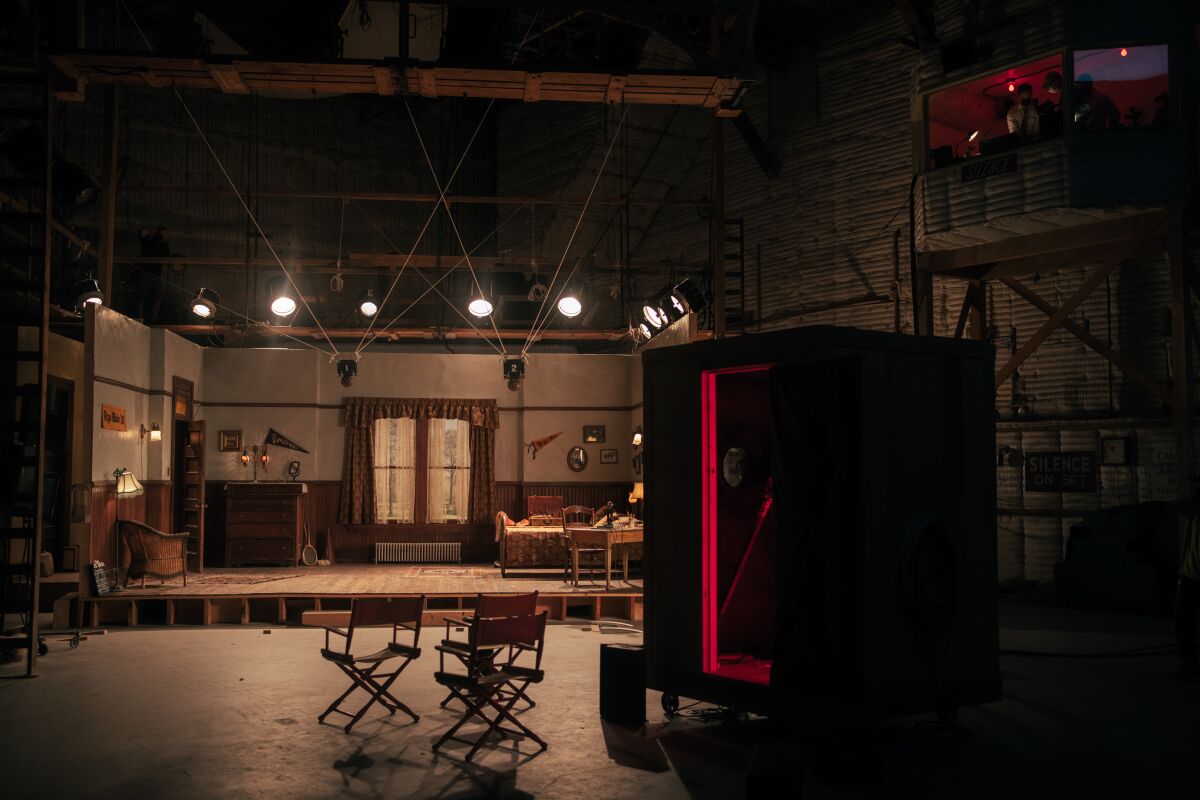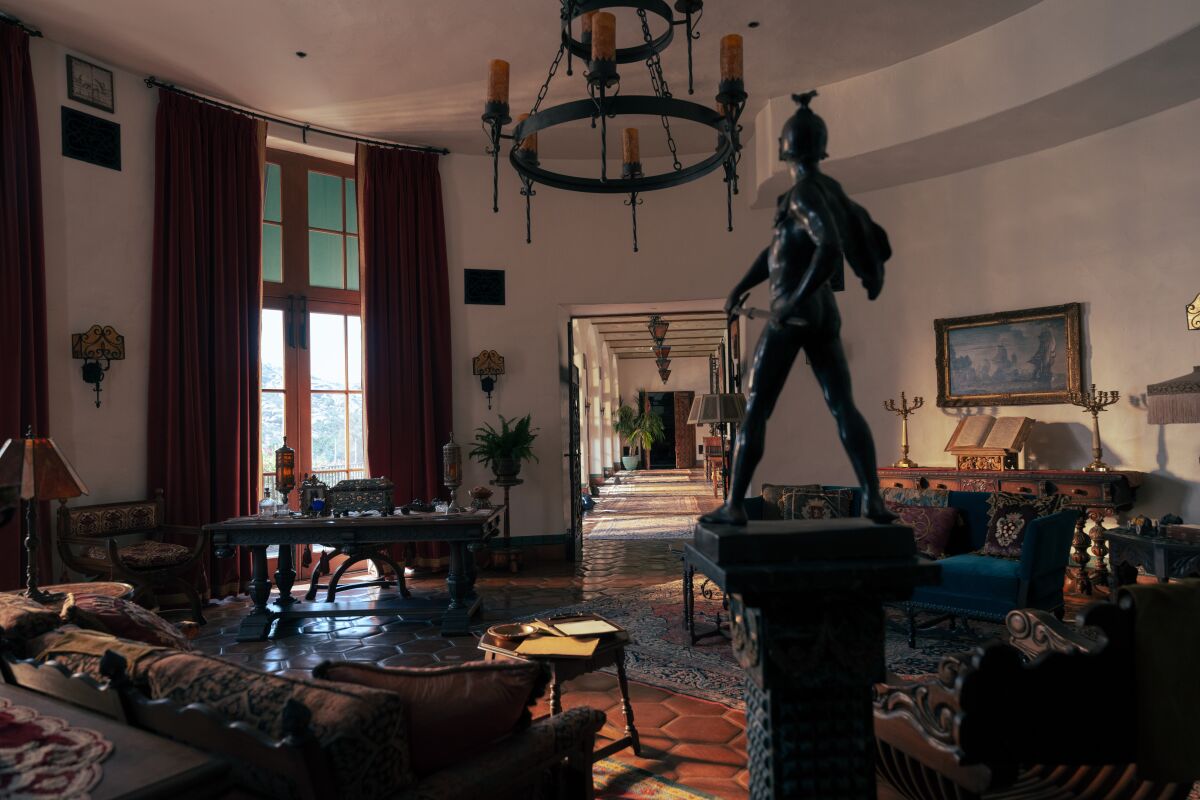In “Babylon,” Manny Torres (Diego Calva) is a kid with a dream in silent-era Hollywood. “I always wanted to be part of something bigger, something that lasts, that means something, something more important than life!” he exclaims over a cocaine-fueled powwow with fledgling actor Nellie LaRoy (Margot Robbie).
Production designer Florencia Martin can relate. A native Angeleno who, like so many, grew up in the shadow of Hollywood, she assumed the dream factory was closed to people like her. But after studying theatrical sets and costumes at Carnegie Mellon University, she landed a job on “Mad Men” in 2008, working in the art department as a set decorator.
“I just loved being on set and creating these worlds,” Martin says. “From there I worked back toward production design, my ultimate goal.”
In 2021 she secured that status with “Licorice Pizza,” receiving her first major feature film production design credit on a project that was nominated for three Oscars. Now she’s followed with two films in the Oscar mix this year — Ana de Armas’ Marilyn Monroe pic, “Blonde,” and “Babylon,” director Damien Chazelle’s delirious take on silent-era Hollywood and the transition to talkies.
Outdoor production stages were common to early Hollywood filmmaking, like this Gold Rush-era saloon in which the Nellie character (Margot Robbie) gets her big break.
(Scott Garfield / Paramount Pictures)
“Los Angeles was a kaleidoscope of architecture you still see today,” Martin says. Among the movie’s 120 sets, she cites the Spanish Mission Revival mansion inhabited by fading star Jack Conrad (Brad Pitt), to the Craftsman home that Manny lives in or producer Don Wallach’s (Jeff Garlin) Spanish Gothic castle and the home of gossip columnist Elinor St. John (Jean Smart), which was filmed at Pasadena’s Castle Green, built in the 1890s before anyone had ever heard of Hollywood.
Like Julia Morgan’s design for Hearst Castle, a Frankenstein patchwork of architectural styles, LA showcased artistic inspirations from all over. Instead of traveling to San Simeon for the scene at the Hearst party in which Nellie purges herself of pretentious airs (and a whole lot more), Martin and her team looked at the old Hearst Beach House, built for starlet Marion Davies and now known as the Annenberg Community Beach House in Santa Monica.
When that didn’t work out, they considered Hearst’s Beverly Hills estate (also designed by Morgan), which was used in “The Godfather.” Finally they arrived at a Beaux Arts Italianate manse on West Adams formerly owned by Busby Berkeley, neighbor to Fatty Arbuckle. “These places all came with film history,” Martin notes.
“Babylon” begins with a shower of elephant poop, which might seem like a crass joke but is really a metaphor for what this town does to wannabes and has-beens. Said pachyderm is on his way to a mansion in Bel-Air, at the time still a dusty desert mountain, for a party hosted by movie mogul Wallach. What follows is a highly choreographed bacchanalia set in Wallach’s opulent living room, an exotic Spanish Gothic Revival space that is actually the lobby of downtown’s Ace theater, built for United Artists in 1927 by the architectural firm Walker & Eisen.

“Damien and I really wanted to create a terrifying experience for when they’re coming into sound,” says production designer Florencia Martin, “with big giant lights and this spider web of microphones over your head.”
(Scott Garfield / Paramount Pictures)
“When we were scouting the Ace theater for one of our film premieres, the second we stepped into the foyer we said we’re going to shoot here,” Martin recalls, noting the production was helped by the pandemic, which had left the theater empty and available. Martin’s team installed a parquet floor, built a bandstand for live jazz accompaniment and transformed all the doorways to look like openings into the home.
The mansion’s exterior, a castle-like structure from the era, was built in Lancaster by Hancock Park developer Richard Peter Shea. It too was the site of lavish parties like the one depicted in the film, with a facade that required practical and digital augmentation. But the film’s biggest challenge was a battlefield backdrop for a climactic kiss between Conrad and his leading lady in his final silent film, the capstone on his career. It required 900 extras working in 110-degree heat over three days.
Less stressful were the many sets within sets, such as the outdoor production stages common to the era. A sprawling field bustles with performers and film sets — some under construction, some before the cameras and others being struck — a jungle, an Asian city, or a gold rush era saloon in which Nellie gets her big break.

The interior of the Spanish mission revival mansion inhabited by fading star Jack Conrad (Brad Pitt) in “Babylon” is jampacked with details.
(Scott Garfield / Paramount Pictures)
“What we wanted to do was really project what it felt like to be filmmaking without sound. So, you could run around, run amok with structures rising and falling,” recalls Martin. “It’s one of my favorite sets in the film, because it really represents the ethos of what it felt like with these dreamers who are fabricating their environments and destroying them at the same time.”
More challenging than erasing modern signage at Paramount and masking modern air-conditioning ducts was building sets on soundstages where filmmakers were first exposed to the tyranny of audio, marking the end of the freewheeling silent era. “Damien and I really wanted to create a terrifying experience for when they’re coming into sound, this sarcophagus of a studio,” Martin says. “So, you step into sound, dark with big giant lights and this spider web of microphones over your head.”
For “Licorice Pizza” Martin re-created San Fernando Valley in the 1970s, a time and place not far from her own experience growing up in different parts of LA For “Babylon,” she re-created Hollywood in the 1920s, a time and place not far from her heart. “As a Latina and first-generation American, and following the footsteps of Manny, I worked really hard to get to this point,” she says, name-checking the film’s main character.
With “Babylon” marking her third major film as production designer, she doesn’t anticipate an Oscar nod just yet but simply appreciates the work at hand. “To be able to even create this film, to be given the resources to build a film studio, re-create the silent era and shoot in all of these different architectures, that on its own has been such an awesome journey.”


Comments are closed.